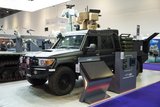Lockheed Martin battle command system in testing
Active Army units have been testing a Lockheed Martin web-based system that combines the power of Google Earth, Command and Control web applications and existing tactical communications systems to deliver a common operating picture of the battlefield to any network user with a laptop. Command Web provides users with a web-based view of the mission command picture to both the commander in the tactical operating center as well as warfighters in the battlespace.
"Command Web extends the collaborative capabilities of mission command systems for those who don't have the real deal," said Lt. Col. Thomas Bentzel, the Army's product manager for Tactical Mission Command. "It's got great potential for expansion and convergence with other systems."
The Command Web system is being tested by soldiers in theater to validate the system's architecture, requirements and user interface design. Both the Army and Lockheed Martin are using feedback from the testing to refine requirements and prioritize ongoing development for future system rollouts that will continue to expand, ultimately providing as much as 80 percent of current mission command functionality via the web environment.
"Command Web brings the big picture down to the company level," said Jim Quinn, vice president with C4ISR Systems for Lockheed Martin IS&GS-Defense. "It also provides any user with access to the Army's tactical network with actionable data to support their missions."
Designed with a standard Army Battle Command Systems interface, Command Web mimics the functionality, naming conventions and other attributes of the Army's primary common operational picture viewer that is used in all theaters. With its web-based capability, Command Web significantly reduces the logistical support footprint for the operational user. The system's software developer's kit enables rapid third-party development of new warfighting capabilities.
Basing the system on the National Security Agency's Ozone framework offers a non-proprietary, government-owned solution that allows for maximum interoperability. Since the Ozone framework is also used by the web version of the Distributed Common Ground System - Army (DCGS-A), the Army's ISR enterprise, it lays the groundwork for future interoperability across the intelligence and operations communities.
Source: Lockheed Martin
More from Digital Battlespace
-
![Babcock nears first customer for Nomad AI translation tool]()
Babcock nears first customer for Nomad AI translation tool
Nomad can provide militaries with real-time intelligence, saving critical time on the battlefield.
-
![AUSA 2025: Israel’s Asio Technologies to supply hundreds of improved Taurus tactical systems]()
AUSA 2025: Israel’s Asio Technologies to supply hundreds of improved Taurus tactical systems
Taurus operates alongside the Israel Defense Forces’ Orion system which supports mission management across tens of thousands of manoeuvring forces, from squad leaders to battalion commanders.
-
![AUSA 2025: Kopin pushes micro-LED plans as China moves faster]()
AUSA 2025: Kopin pushes micro-LED plans as China moves faster
The plan for the new displays follows fresh investment in Kopin’s European facilities by Theon and an order for head-up displays in fielded aircraft, with funding from the US Department of Defense.
-
![AUSA 2025: Persistent Systems to complete its largest order by year’s end]()
AUSA 2025: Persistent Systems to complete its largest order by year’s end
Persistent Systems received its largest ever single order for its MPU5 devices and other systems earlier this month and has already delivered the 50 units to the US Army’s 4th Infantry Division.
-
![Aselsan brings in dozens of companies and systems under the Steel Dome umbrella]()
Aselsan brings in dozens of companies and systems under the Steel Dome umbrella
Turkey has joined the family of countries attempting to establish a multilayered air defence system with government approval in August 2024 for the effort landed by Aselsan. Dubbed Steel Dome, the programme joins Israel’s Iron Dome, the US Golden Dome, India’s Mission Sudarshan Chakra and South Korea’s low-altitude missile defence system.
-
![DSEI 2025: MARSS unveils new agnostic multidomain C4 system]()
DSEI 2025: MARSS unveils new agnostic multidomain C4 system
MARSS’ NiDAR system has been deployed using sensors from static platforms to provide detection and protection for static sights, such as critical infrastructure, ports and military bases.




























